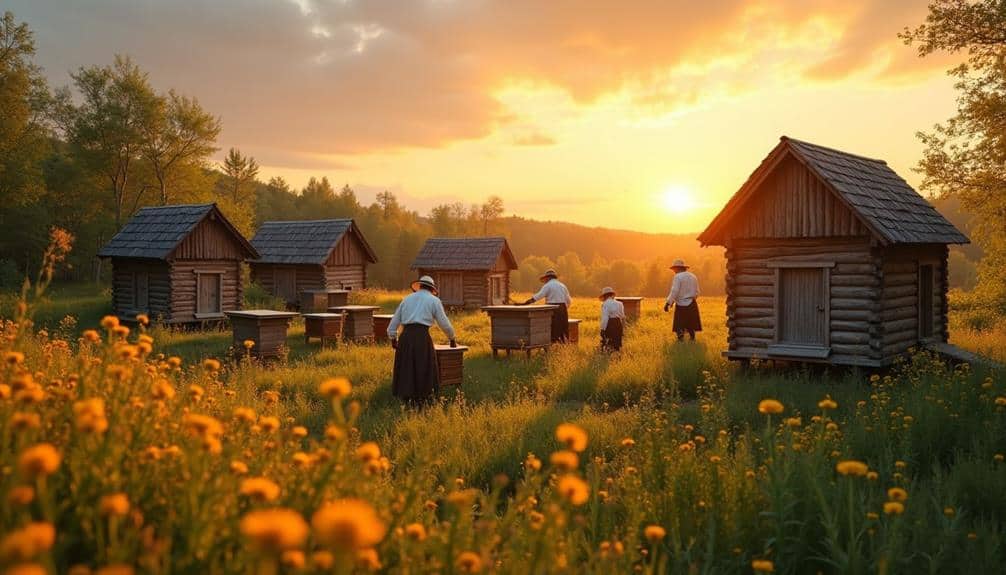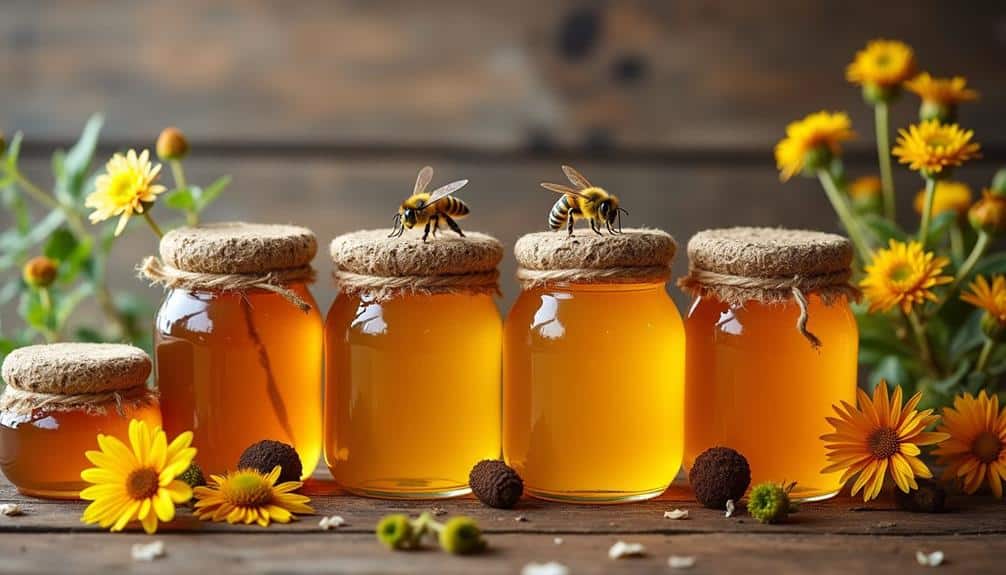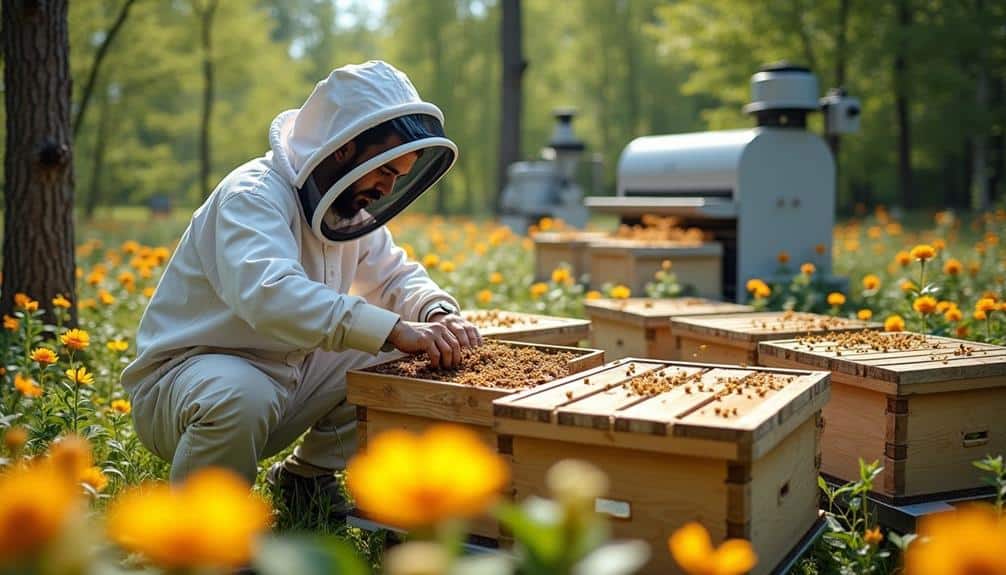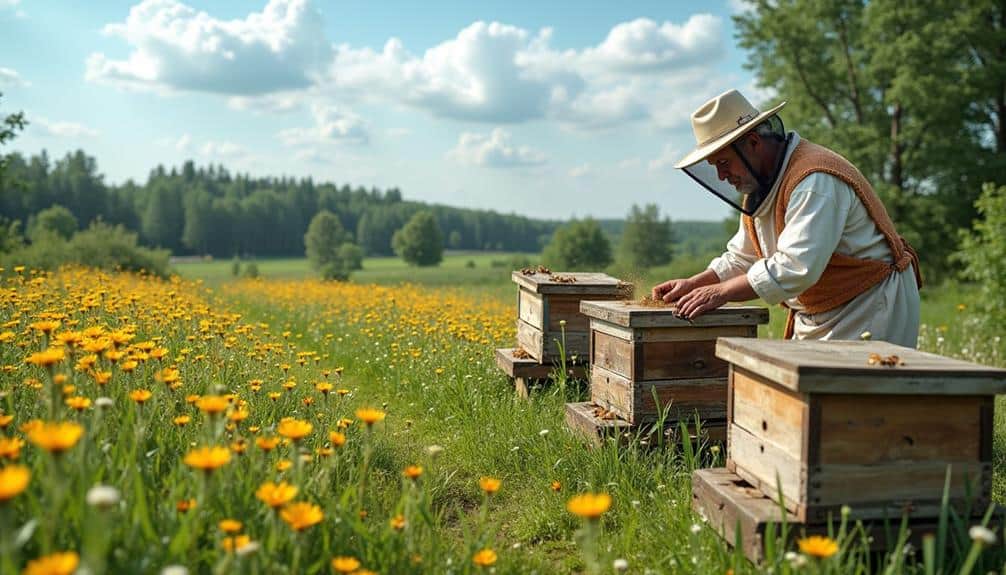Beekeeping in Russia, a practice deeply embedded in the country’s history, has evolved from ancient traditions to a modern industry. Regions such as Altai, Siberia, and Krasnodar are renowned for producing distinctive honey varieties like buckwheat and linden honey, each celebrated for unique flavors and health benefits. Advances in hive technology and the rise of urban beekeeping reflect a commitment to sustainability, while global demand for organic honey has bolstered Russia’s standing in international markets. What remains particularly intriguing are the methods and innovations driving this change, as well as the broader economic and environmental implications.
Historical Background

The historical background of beekeeping and honey production in Russia is deeply rooted in the country’s agricultural traditions. Dating back to ancient practices, beekeeping has been a cornerstone of rural life and an essential aspect of the economy. The earliest records indicate that Slavic tribes engaged in wild bee hunting, a practice known as “bortnichestvo,” which involved collecting honey from tree hollows where bees naturally nested.
These ancient practices evolved over centuries into more organized and systematic methods of beekeeping. Honey held significant cultural importance in Russian society. It was not only a primary sweetener before the widespread availability of sugar but also an important ingredient in traditional beverages such as mead.
Additionally, honey and other bee products like beeswax played a role in various religious and medicinal applications, underscoring their cultural significance. Throughout history, beekeeping in Russia shifted from these primitive methods to more sophisticated techniques, reflecting advancements in agricultural science and technology.
Key Regions
Prominent beekeeping regions in Russia, such as the Altai Territory, Bashkortostan, and the Central Federal District, have each developed unique practices and traditions in honey production.
The Altai Territory, for instance, is renowned for its pristine Altai hives, which benefit from the region’s diverse flora. The Krasnodar region, with its temperate climate, supports a robust honey industry, producing high-quality honey that is highly sought after both domestically and internationally.
In Siberia, apiaries thrive despite the harsh climate, thanks to innovative techniques that protect bees during the cold months. Siberian apiaries are known for producing a rich, aromatic honey that reflects the unique characteristics of this vast region.
Ural beekeeping, situated between Europe and Asia, benefits from a diverse floral landscape, contributing to the production of distinctive honey varieties.
The Volga region, with its expansive steppes and river valleys, produces Volga honey, celebrated for its purity and flavor. Meanwhile, Far East production leverages the unique biodiversity of its remote forests, yielding honey with distinct flavors and medicinal properties.
Each of these regions contributes to Russia’s rich and varied honey production landscape, showcasing the country’s diverse environmental and cultural heritage.
Types of Russian Honey

Russia’s honey landscape is as vast and diverse as its geography, offering a plethora of unique honey types that reflect the country’s varied flora and regional practices. Each honey variety presents distinct taste profiles and medicinal uses, shaped by the floral sources available in different regions.
For instance, Bashkiria is renowned for its linden honey, celebrated for its delicate flavor and therapeutic properties, while the Altai region produces buckwheat honey, known for its dark color and robust, earthy taste.
Regional differences in climate and vegetation lead to a wide array of honey varieties. Siberian honey, often derived from wildflowers, boasts a rich, aromatic profile, whereas the honey from the Caucasus is prized for its floral notes and light consistency.
Seasonal production also plays a significant role, with spring and summer yielding different floral sources that influence the honey’s characteristics.
Cultural significance is deeply embedded in Russian honey, often featured in traditional recipes and folklore.
However, beekeeping challenges such as harsh winters and habitat disruption affect seasonal production and the diversity of honey types. Consequently, Russian beekeepers must adapt to guarantee the sustainability and quality of their honey, preserving its unique regional and medicinal attributes.
Traditional Methods
Beekeeping in Russia is enriched by various traditional methods that have been refined over centuries and tailored to the country’s diverse landscapes and climates. The foundation of these practices lies in meticulous swarm management, which guarantees the health and productivity of bee colonies.
Russian beekeepers traditionally use hive designs like the log hive, which offers insulation against harsh winters and maintains the natural habitat for native bee species such as Apis mellifera.
Seasonal practices are integral to Russian beekeeping, with activities timed to the rhythm of nature. In spring, beekeepers focus on hive inspection and preparation, while summer is dedicated to honey collection and swarm control. The autumn season involves guaranteeing hives are well-stocked with food for winter survival.
The cultural significance of beekeeping in Russia is profound, with honey and bee products deeply embedded in folklore and traditional medicine. Honey is not only a staple in the diet but also acclaimed for its medicinal uses, from treating wounds to alleviating sore throats.
These time-honored practices underscore the symbiotic relationship between Russian beekeepers and their environment, preserving an ancient craft that sustains both human and bee populations.
Modern Innovations

Embracing technological advancements, modern innovations in Russian beekeeping have revolutionized the industry, enhancing both productivity and sustainability. Central to this transformation is the development of advanced hive technology, which optimizes temperature control and ventilation, ensuring ideal conditions for bee colonies. These innovations are crucial in promoting sustainable practices, as they minimize the environmental impact while maximizing output.
Pollinator health remains a top priority, with cutting-edge research into bee genetics enabling the breeding of more resilient bee populations. This genetic advancement reduces susceptibility to diseases and pests, contributing to healthier hives.
Additionally, urban beekeeping has gained traction in Russian cities, integrating bees into urban ecosystems and fostering community awareness about the importance of bees in pollination.
Honey processing has also seen significant strides, with state-of-the-art facilities ensuring higher purity and quality, meeting rising market trends for organic and natural products.
Educational programs have been implemented nationwide, equipping new and experienced beekeepers with knowledge on modern techniques and sustainable practices. These programs are essential in maintaining high standards and adapting to evolving industry demands.
Collectively, these innovations solidify Russia’s position in the global honey market, driving growth through forward-thinking approaches.
Economic Impact
The modernization of beekeeping practices in Russia not only enhances the industry’s sustainability but also considerably boosts its economic impact. As contemporary techniques and technologies are increasingly adopted, the productivity of Russian apiaries has surged, aligning with emerging market trends. These advancements are instrumental in meeting both domestic and international demand, hence expanding the industry’s economic footprint.
One significant aspect of this economic growth is the export potential of Russian honey. The country, known for its diverse flora, produces a variety of high-quality honey that appeals to global markets. By leveraging modern beekeeping practices, Russian producers are better positioned to meet stringent international standards, thereby enhancing their competitiveness on the world stage.
The rising demand for organic and natural products further bolsters this export potential, as consumers worldwide seek premium honey.
Additionally, the domestic market has benefited from these innovations. Enhanced productivity and quality control measures have led to increased consumer confidence and higher sales within Russia.
Observing these market trends, it is evident that the modernization of beekeeping practices is not merely a technological shift but also a catalyst for substantial economic benefits, both locally and internationally.
Environmental Benefits

Modernizing beekeeping practices in Russia yields numerous environmental benefits, which extend beyond mere economic gains. One of the most significant advantages is pollinator protection. Bees play a critical role in the pollination of various crops and wild plants, contributing to the overall health of ecosystems. By adopting advanced beekeeping techniques, Russian beekeepers can better manage and safeguard bee populations, ensuring their resilience against diseases, pesticides, and habitat loss.
Another key environmental benefit is biodiversity enhancement. Bees are instrumental in the reproduction of a wide array of plant species, which in turn supports a diverse range of wildlife. Modern beekeeping practices, such as the establishment of bee-friendly habitats and the reduction of chemical use, foster healthier ecosystems. This not only helps in maintaining plant diversity but also supports various animal species that depend on these plants for food and shelter.
Furthermore, sustainable beekeeping practices can contribute to soil health and water conservation. Pollinators enhance the growth of plants, which can stabilize soil and improve its quality.
Additionally, diverse and healthy plant life can enhance water retention in the soil, reducing erosion and promoting a balanced hydrological cycle.
Global Recognition
Recognition on the global stage has increasingly become a point of pride for Russia’s beekeeping industry. Russian honey is not only renowned for its quality but also deeply rooted in the country’s cultural significance. Traditional beekeeping practices, passed down through generations, contribute to the unique flavors and high standards that characterize Russian honey. This heritage, combined with modern techniques, has garnered international acclaim and elevated the country’s status as a leading honey producer.
The global recognition of Russian honey is also substantially driven by international trade. With a growing demand for pure and organic honey, Russia has positioned itself as a significant exporter, reaching markets across Europe, Asia, and North America. Russian beekeepers have capitalized on this demand by maintaining stringent quality control measures and adhering to international standards.
Moreover, participation in global expos and competitions has further highlighted the excellence of Russian honey, earning numerous awards and distinctions. These accolades not only boost the country’s reputation but also foster deeper trade relationships.
Fundamentally, the global recognition of Russia’s beekeeping industry is a reflection of its cultural significance and a catalyst for expanding international trade.




